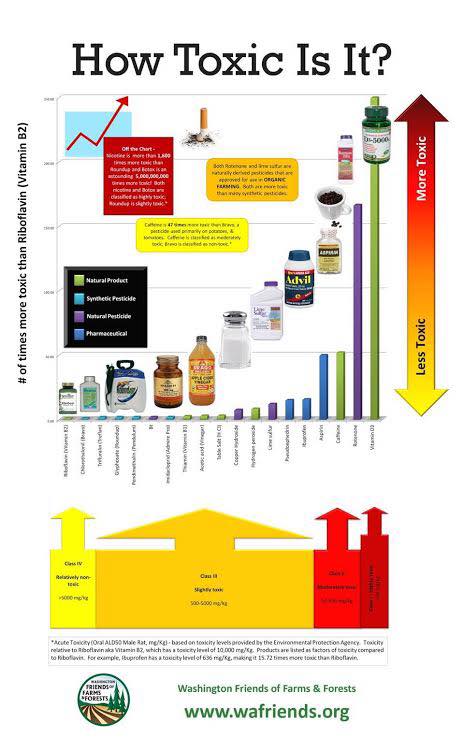|
If someone were to pull out a pack of cigarettes, smoke one in front of you and then when they were done, proclaim that this proves tobacco products are safe, you'd think they were pretty crazy right? Yet, this exact same type of argument is regularly being used to defend the use of toxic pesticides - most often seen with glyphosate. When approaching decision makers about toxic pesticide use most advocates, if not all us, have run into some form of acute toxicity comparison with pesticide products. LD50 (lethal dose 50%), or the median lethal dose, is the measure used to account for the acute toxicity or short-term poisoning potential of a substance that when given at one time causes the death of 50% of a group of test animals. These measurements help determine the signal word on a pesticide product; CAUTION, WARNING and DANGER. These signal words are useful to the person applying the pesticide, but they do not account for the risk of long-term chronic exposure to pesticides which is the main focus of community concerns. And yet, when discussing this issue, groups have received promotional literature from the manufacturer, or are presented with lists of acute toxicity comparisons from pesticide industry trade groups like this one to help "ease" their concerns. This graphic is lying to us with facts - while the acute toxicity of these substances are correct, comparing them like this is very deceptive. This is a clear example of false equivalence. Salt, also known as sodium chloride, is an essential mineral that we all need in proper amounts. Nobody needs to replace Bravo, Treflan, Roundup and Pendulum when they sweat profusely. These chemical concoctions serve no function in the human body, they are classified as xenobiotics. Vitamin D is a hormone, essential to immune function. Normally our skin makes it when exposed to sunlight and we absorb what we need. Taking a whole bottle of synthesized vitamins is a very bad idea. But that doesn’t mean being exposed chronically to a little pesticide is a good idea. Dose is important, but it doesn’t make the poison, despite what you’ve heard - this is very old, outdated science. We know there are dose response curves that are not linear, for endocrine disrupting chemicals (EDCs) and substances like lead and chlorpyrifos cause harm at very low levels. There are no safe levels of exposure to some toxic chemicals like lead, or to asbestos that has such low acute toxicity it has no LD50 assigned to it. This was used as a frequent argument to prove how safe it was by the industry that sold it. Sound familiar? Another reason this argument is misleading is that pesticide products are more than just a singular active ingredient. The formulated product being sold and used on landscapes have added adjuvants - other chemical ingredients designed to help the active ingredient work better - usually listed by percentage as "other" or "inert" ingredients on the label. The actual chemical names of these ingredients are not required to be listed. The acute toxicity of the final formulated product is generally not required to be tested. In one independent study that did test it was found that Roundup was 125 times more toxic than glyphosate. The U.S. National Toxicology Program has also found the formulations to be much more toxic than the active ingredient alone. Acute toxicity is only one measure of toxic effects. It’s relevant to people spraying a pesticide, so they know what type of precautions to take and protection to wear, but it’s completely irrelevant in the context of chronic exposure. Getting back to the example at the outset, smoking is perfectly safe when you only look at acute toxicity. DDT has a very low acute toxicity but we now know it can cause breast cancer, and that the timing of exposure is a determining risk factor. Recently, Washington State University researchers have found a variety of diseases and other health problems in the second and third generation offspring of rats exposed to glyphosate. This blows the argument that glyphosate is somehow safer than table salt. So dose matters, yes, but the dose alone doesn’t make the poison - sub-lethal effects, chronic toxicity, timing, sequence of exposures, combinations of exposures, individual susceptibility and many other factors determine the toxicity of a substance. When this argument inevitably comes up, you should be armed with the knowledge to refute it and steer the conversation back to the core issue of chronic low level exposures to toxic pesticides by the public. See our Myths PDF for more. |
Archives
March 2024
Categories |
|
Non Toxic Communities is a 501 (c) (3) charitable organization
Nontoxic Communities Foundation, Inc. dba Non Toxic Communities Copyright © 2024 Non Toxic Communities - All Rights Reserved Site design by Bee Rooted | About Us | Contact Us |

 RSS Feed
RSS Feed
